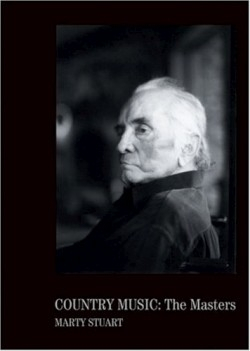Country Music
The Masters
At bottom, country music is about the abiding joys of home—both real and imagined. Take away the songs that express in one way or another a longing to return to the comforting place of one’s childhood, and there would be precious little of this music left. The armature of home life is, of course, the family; and it is the familial nature of the performers who created modern country music that Marty Stuart illuminates in this collection of snapshots and formal portraits. Stuart took most of these photos while he was playing in or leading various country bands. There is significantly more to this book, though, than just a procession of famous and semi-famous faces. Stuart also offers photos of ornate stage costumes, show posters, stars’ tombstones, first drafts of classic songs, fabled guitars, mandolins and fiddles, ancient cabins and farm buildings, honky tonks, country churches, and the scenes of Patsy Cline’s plane crash and Stringbean’s murder. (Those who’ve never heard of Stringbean will find less to savor in this book than those familiar enough with country music to remember him as the lanky, banjo-playing comedian from Hee Haw. This is very much an insider’s book, not a fact- and date-laden introduction to the subject.)
No one else in country music today is as well suited to convey the music’s essence as the Mississippi-born Stuart. A prodigy on the mandolin, he began performing professionally when he was twelve years old, and at thirteen he joined the legendary Lester Flatt’s band. Later, he toured for several years with Johnny Cash (and married his daughter, Cindy) before venturing out on his own. He went on to win four Grammy awards and become a revered member the Grand Ole Opry.
Besides his instrumental skills, Stuart brings to this work an encyclopedic knowledge of country music and a curator’s zeal for collecting, cataloging, and annotating its artifacts. He has amassed one of the largest collections of country music memorabilia in private hands—some 20,000 items. Very early in his career, Stuart saw in a Greenwich Village bookstore a series of behind-the-scenes photos of jazz stars taken by jazz bassist Milt Hinton, who, as it turned out, carried a camera with him to all his gigs. Realizing that he, too, had a rare degree of access to famous artists, Stuart decided to do the same. Thus began the visual treasury this book incorporates.
Many of Stuart’s pictures are masterpieces of character and mood. One shows Bill Monroe, the originator of bluegrass music, playing mandolin for a flock of chickens, as his long white limousine stretches behind him. In another, Monroe and Flatt shake hands on stage to end a feud that had kept them apart for twenty-five years. Then there’s the garishly decorated gravesite of Teddy and Doyle, the Wilburn Brothers, a nightmare of sepulchral overkill. Stuart also includes the surprisingly well-composed photo he took of singer Connie Smith when she performed in his hometown in 1970. Although only twelve at the time, he told his mother that he would one day marry Smith—and twenty-seven years later, he did. However, the most moving of Stuart’s images is his cover photo of Johnny Cash, taken four days before his death. In it, his jaw sunken, his nose strong and straight, his eye open but blank, Cash looks like he’s chiseled from stone.
Enriching this collection is an enhanced CD that contains sixteen of Stuart’s spoken word narrations, four cuts of his instrumen-tal music, one song (“Dark Bird,” a tribute to Cash) and a music video of that song. It will mean more if one listens to the CD before paging through the book, even if one is conversant with country music. Stuart tells the stories behind many of the most eloquent photos, including those of Smith and Monroe. He also details Stringbean’s murder and explains why it took him so long to re-visit and photograph the house where the killing took place.
Impressive though it is, the book has its flaws. Some of the performers pictured are “masters” only in the most elastic sense. Other undisputed masters are left out entirely, among them Conway Twitty, Barbara Mandrell, Reba McEntire, Ronnie Milsap, and Don Williams. It would be helpful, particularly to researchers, if the captions were more thorough and included dates and locations. But these are quibbles. Overall Stuart has achieved what he sought, and that was to illustrate through its practitioners the richness, beauty, and dignity of this often denigrated art form. Certainly, he ranks high among the masters he celebrates.
Reviewed by
Edward Morris
Disclosure: This article is not an endorsement, but a review. The publisher of this book provided free copies of the book to have their book reviewed by a professional reviewer. No fee was paid by the publisher for this review. Foreword Reviews only recommends books that we love. Foreword Magazine, Inc. is disclosing this in accordance with the Federal Trade Commission’s 16 CFR, Part 255.

